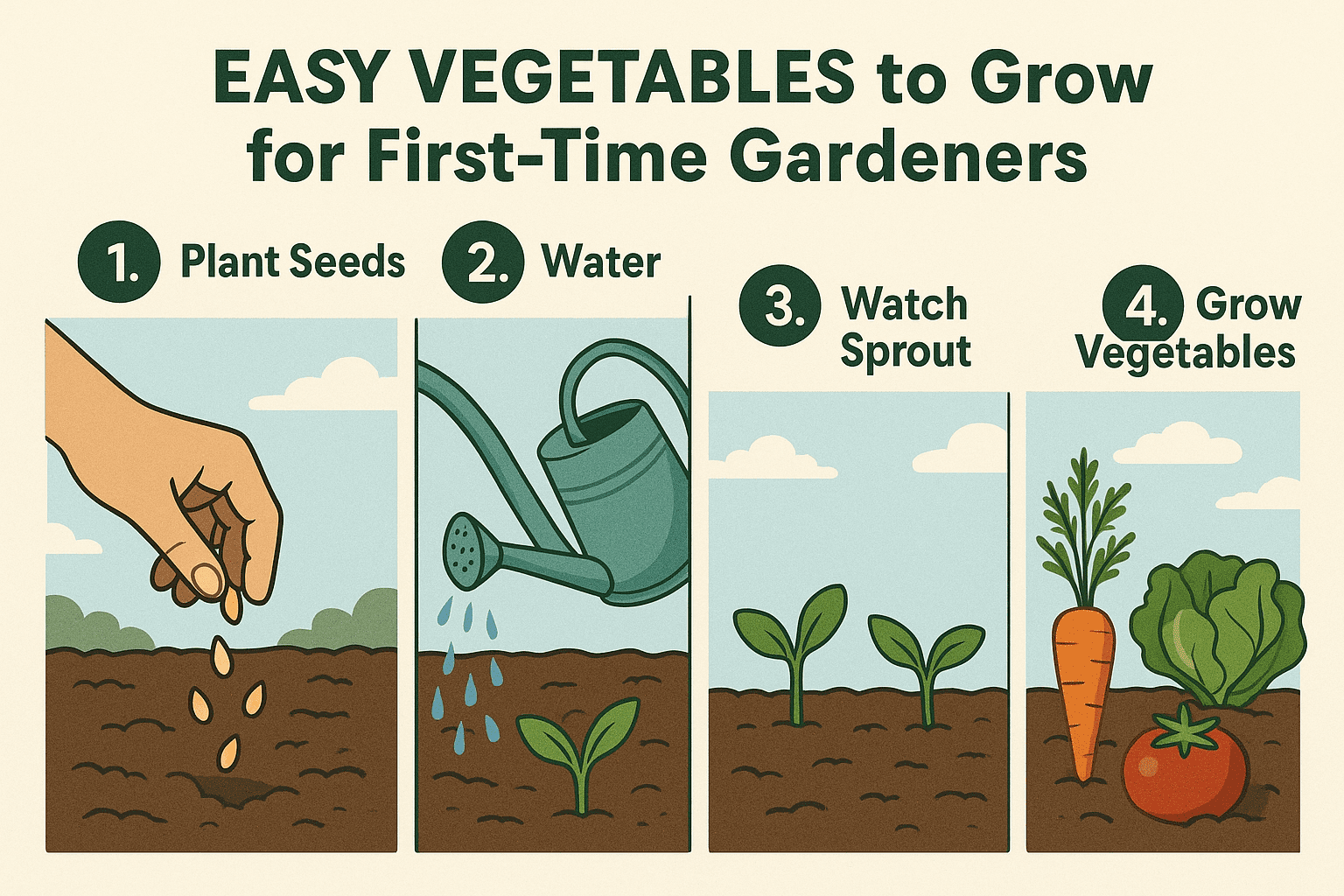Starting your own vegetable garden can feel overwhelming, especially if you’re new to gardening. Fortunately, there are easy vegetables to grow for first-time gardeners that don’t require expert knowledge, expensive equipment, or a large backyard. Whether you’re planting in containers, raised beds, or a small garden patch, these beginner-friendly veggies will help you grow confidence—and dinner.
Why Start with Easy Vegetables?
Choosing the right vegetables is key for beginners. Simple-to-grow crops offer:
- Quick rewards
- Minimal maintenance
- High tolerance for mistakes
- Low cost of entry
By starting with forgiving vegetables, you build essential skills and enjoy a successful first harvest.
H2: Best Easy Vegetables for First-Time Gardeners
Let’s dive into the top beginner-friendly vegetables that grow well in most environments.
H3: 1. Radishes
Radishes are perfect for impatient gardeners. They grow quickly—most are ready to harvest in just 3–4 weeks.
Why it’s great for beginners:
- Germinates in less than a week
- No complex maintenance
- Can be planted in small containers
Tip: Keep soil moist and plant in cool seasons for the best flavor.
H3: 2. Lettuce and Leafy Greens
Leafy greens like lettuce, spinach, and arugula are fast-growing and do well in partial sunlight.
Why it’s great:
- Grows in pots, window boxes, or garden beds
- Ready to harvest in 30–45 days
- Can be harvested multiple times
Tip: Cut outer leaves and allow inner leaves to keep growing (cut-and-come-again method).
H3: 3. Green Beans
Bush beans grow compactly, making them ideal for beginners without much space.
Why it’s great:
- Low maintenance and fast growing
- Doesn’t require staking (bush variety)
- Harvest within 50–60 days
Tip: Pick regularly to encourage more pods.
H3: 4. Zucchini
Zucchini is prolific. A single plant can produce plenty of vegetables throughout the season.
Why it’s great:
- Fast-growing and forgiving
- Tolerant to various soil types
- Great for garden beds or large containers
Tip: Harvest when about 6–8 inches long for best flavor.
H3: 5. Cherry Tomatoes
Though tomatoes need sun and water, cherry tomatoes are easier than larger varieties.
Why it’s great:
- Can grow in pots or hanging baskets
- Yields high volumes
- Resilient against minor neglect
Tip: Use a tomato cage for support and water regularly.
H3: 6. Carrots
Carrots are fun and rewarding, especially for children watching them grow underground.
Why it’s great:
- Minimal care needed
- Thrives in deep, loose soil
- Harvested in 60–80 days
Tip: Thin seedlings to allow enough space for roots to expand.
H2: Step-by-Step Guide to Get Started
H3: Step 1: Choose Your Location
Pick a sunny spot that gets 6–8 hours of sunlight daily. If that’s not possible, start with leafy greens which tolerate partial shade.
H3: Step 2: Select Your Containers or Garden Bed
Use recycled pots, raised beds, or grow bags. Just ensure proper drainage holes and adequate soil depth (6–12 inches depending on the crop).
H3: Step 3: Prepare the Soil
Use organic potting mix or compost-enriched garden soil. Loose, well-draining soil helps roots grow strong.
H3: Step 4: Sow the Seeds
Follow seed packet instructions. In general:
- Sow shallowly for small seeds (lettuce, carrots)
- Space appropriately to avoid overcrowding
- Water gently after planting
H3: Step 5: Water Regularly
Keep the soil moist but not soaked. Most veggies prefer consistent watering 2–3 times per week.
H3: Step 6: Monitor Growth and Harvest
Watch for pests, yellowing leaves, or signs of stress. Harvest as soon as vegetables are mature to enjoy peak flavor.
H2: Bonus Tip – Keep It Sustainable
Repurpose containers like buckets, crates, or even yogurt cups as planters. Reuse kitchen scraps to start compost. Every small eco-friendly step makes a difference.
H2: Common Beginner Mistakes to Avoid
- Overwatering or underwatering: Learn your plant’s needs.
- Crowding plants: Leads to poor airflow and disease.
- Neglecting sunlight: Choose sun-loving veggies for best results.
For more tips, read our article on gardening mistakes most beginners make.
H2: Where to Get Your Gardening Supplies
Need gardening tools, starter pots, or organic seeds? Find beginner-friendly gardening supplies on Amazon to help you grow your first vegetables with ease.

Before planting, be sure to avoid these common errors — check out our guide on gardening mistakes most beginners make to set yourself up for success.
Conclusion
Starting a vegetable garden doesn’t need to be difficult. These easy vegetables to grow for first-time gardeners are your gateway to fresher food, better health, and a rewarding new hobby.
Save this guide for your next planting weekend and share it with a friend who’s just getting started. Growing your own food is easier—and more enjoyable—than you think.
FAQ
Q1: What vegetables grow well in pots?
Lettuce, radishes, cherry tomatoes, and bush beans thrive in containers. Just make sure the pot has good drainage.
Q2: When is the best time to start planting?
Early spring is ideal for most vegetables. However, leafy greens can also be planted in fall.
Q3: How often should I water my vegetable garden?
Water 2–3 times a week depending on your climate. The goal is to keep the soil evenly moist.
Need gardening tools, starter pots, or organic seeds? Find beginner-friendly gardening supplies on Amazon to help you grow your first vegetables with ease.
Written by Kate Smith | Plant Care Enthusiast & Urban Gardener
